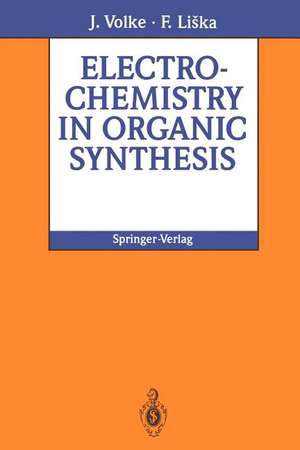Electrochemistry in Organic Synthesis
Autor Jiri Volke, Frantisek Liskaen Limba Engleză Paperback – 18 ian 2012
Preț: 634.18 lei
Preț vechi: 746.09 lei
-15% Nou
Puncte Express: 951
Preț estimativ în valută:
121.39€ • 131.90$ • 102.03£
121.39€ • 131.90$ • 102.03£
Carte tipărită la comandă
Livrare economică 22 aprilie-06 mai
Preluare comenzi: 021 569.72.76
Specificații
ISBN-13: 9783642787010
ISBN-10: 3642787010
Pagini: 168
Ilustrații: VIII, 153 p.
Dimensiuni: 155 x 235 x 9 mm
Greutate: 0.25 kg
Ediția:Softcover reprint of the original 1st ed. 1994
Editura: Springer Berlin, Heidelberg
Colecția Springer
Locul publicării:Berlin, Heidelberg, Germany
ISBN-10: 3642787010
Pagini: 168
Ilustrații: VIII, 153 p.
Dimensiuni: 155 x 235 x 9 mm
Greutate: 0.25 kg
Ediția:Softcover reprint of the original 1st ed. 1994
Editura: Springer Berlin, Heidelberg
Colecția Springer
Locul publicării:Berlin, Heidelberg, Germany
Public țintă
ResearchDescriere
This book has been written as an introduction to the electro synthesis of organic compounds, in particular for organic chemists. Both authors assume that the knowledge of electro chemistry of these specialists is rather poor and is usually based only on the remnants of the teaching in the courses on physical and analytical chemistry during their university stud ies. Even with Czech chemists one cannot expect - as it was in the past - the experience obtained in the courses on polaro graphy. This is the reason why it was deemed necessary to write an introductory text to the electro synthesis of organics both as regards the theoretical and the methodological point of view, i. e. the fundamentals, the experimental setup, the application of various working and reference electrodes, the shape and con struction of electrolysis cells, the use of suitable pro tic and aprotic solvents, the experience obtained with various sup porting electrolytes, the separation and isolation of products, as well as the use of inert gases which prevent the interaction of intermediates and of final products with, for example, oxygen or traces of water. - The second part of the book contains a systematic description of preparative organic electrochemical processes, the interpretation of their mechanisms and several prescriptions for synthesizing characteristical groups of com pounds. As a whole the book is not written in an exhaustive way.
Cuprins
1 Introduction.- 2 Experimental Factors and Methods of Investigation of Electroorganic Reactions.- 2.1 Fundamental Conceptions of Organic.- Electrochemistry.- 2.2 Laboratory Electrolysis Cells.- 2.3 Electrodes.- 2.4 Solvents and Supporting Electrolytes.- 2.5 Inert Gases.- 2.6 Information Obtained by Electroanalytical Methods.- 2.6.1 Possibilities of Electrochemical Methods.- 2.6.2 Possibilities of Physical Methods.- 2.7 Procedures in Laboratory Electroorganic Synthesis.- 2.8 Research into Mechanisms of Electrode.- Processes of (chiefly Mercury) Electrodes.- References to Chapters 1 and 2.- 3 Reactions of Organic Compounds at Electrodes.- 3.1 Direct Anodic Oxidations.- 3.1.1 Oxidation of Saturated Hydrocarbons.- 3.1.2 Oxidation of Unsaturated Compounds.- 3.1.3 Oxidation of Alcohols and Ethers.- 3.1.4 Oxidation of Organic Compounds of Sulfur and Selenium.- 3.1.5 Oxidation of Halogen Derivatives and Oxidative Halogenation of Organic Compounds.- 3.1.6 Oxidation of Amines.- 3.1.7 Electrooxidation of Ions.- 3.1.8 Oxidation of Aromatic Systems.- 3.2 Direct Cathodic Reductions.- 3.2.1 Reactions of Functional Groups.- 3.2.2 Reductions of Cathodically Generated Species.- 3.2.2.1 Additions.- 3.2.2.2 Substitutions (acylation, alkylation).- 3.2.2.3 Pinacolizations and Hydrodimerizations.- 3.2.2.4 Eliminations.- 3.2.2.5 Removal of Protective Groups.- 3.3 Indirect Anodic Oxidations.- 3.4 Indirect Cathodic Reductions.- 4 Acids and Bases Generated at Electrodes.- 4.1 Electrochemically Generated Acids (EGA).- 4.2 Electrochemically Generated Bases (EGB).- References to Chapters 3 and 4.









